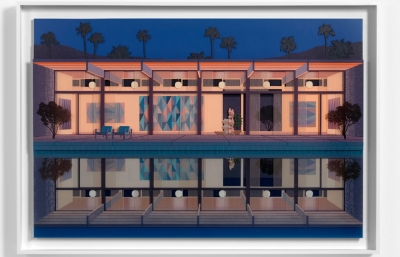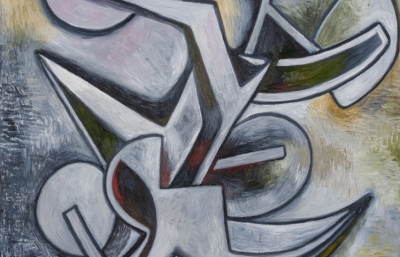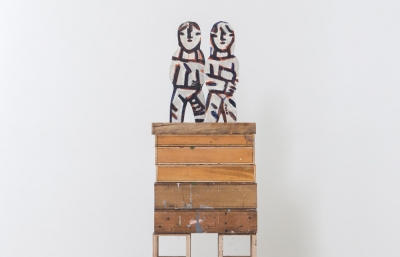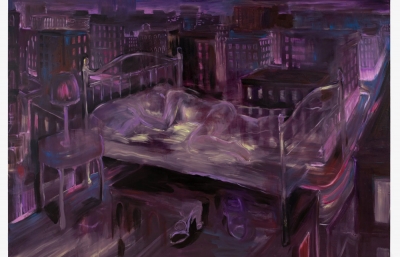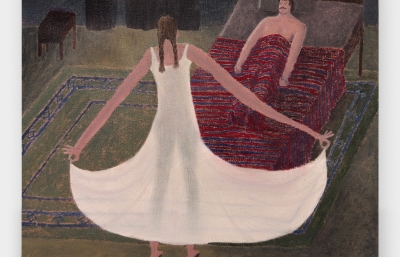
Cheyenne Julien
Body and the Bronx
Interview by Jessica Ross // Portrait by J. Shotti
The life of an artist may seem romantic, but it is not easy. The road to a successful career is obstructed by countless hurdles, massive criticism, and what seems to be a never-ending stream of self-doubt. To produce truly authentic art takes years of listening and trusting oneself to follow instincts based on conviction in your practice. While it’s no easy endeavor, some artists seem to understand the importance of intuition better than others. Meet Cheyenne Julien.
Cheyenne Julien is an ambitious 24-year-old painter with confident, gestural work that speaks volumes to her own experiences growing up and living in the Bronx. With the help of a supportive family and community, she’s been able to follow her feelings and create paintings that are emotive, powerful and sincere in every sense of these words. Weighty and poignant, her figures carry the narratives of Julien’s entire family history. Employing the body as her medium, her subjects pang with nervous energy, some celebratory and joyous, while others reel in private anxiety. Sloe eyed and strong-handed, her figures create thoughtful narratives on canvas, in work that is both beautiful and heartbreaking.
Her most recent series of work explores issues surrounding race, particularly how racism is built into our surroundings and environment via architecture and design. This idea of “environmental racism” was at the centerpiece of her solo show with Smart Objects in Los Angeles last year. Coined by Lauren Pulido in her essay, “Rethinking Environmental Racism: White Privilege and Urban Development in Southern California (2000),” Julien expressed these ideas, recalling her own experience growing up in a high-rise apartment complex in the Bronx and how the relationship to space and nature was thusly formed.
At the precipice of her vocation, Julien is eager to continue learning, practicing and exploring. I was lucky enough to sit down with her this summer and discuss what it means to grow, how it feels to give back and why trusting your instincts is so important.

Jessica Ross: Your paintings feel like a lens into your own personal experiences. Are all the figures in your work iterations of your own personality?
Cheyenne Julien: No, some of my figures are family members, but I do make a lot of self-portraits. Sometimes I recreate moments from specific memories, and sometimes I am just reproducing the feeling of the memory or event. I guess even the figures that aren’t supposed to be me end up taking on my baggage anyways.
You’ve attended some prestigious programs like RISD and the Skowhegan Residency. Do you have any favorite stories from your time at each?
Oh, god, RISD was wild. I am so grateful to have parents who encouraged me to go, even though they couldn’t afford it. There weren’t many black people when I attended, so I felt extremely isolated my first year. All these kids came in equipped with knowledge of art theory, and it made me feel dumb as fuck at the time. I also didn’t have money, so I couldn’t really participate in the social scene the way I wished I could have. There were lots of good times, too, though. I learned a lot there and made some really great lifelong friends. I think it was worth it, though I don’t really have a specific story in mind. Skowhegan was so beautiful, I really miss that place. I went right after I finished undergrad, so I was the youngest one there. I was super intimidated at first, because I felt like, “these people are real artists, how did I get in?” I think that summer was really about overcoming the feeling of self-doubt that art school instilled in me.
Being from the Bronx, you’ve talked about your experience with environmental racism and hereditary trauma and how it plays into your work. What is the message you want to convey and is your practice a form of therapy?
I don’t think I can even pinpoint what I am trying to convey with my work because I work so intuitively. Environmental racism is definitely something that I constantly think about, but my goal isn’t necessarily to teach people or convince them that it exists. I am more interested in showing people how my life has been affected by it. I think creating through lived experience is the only way I know how to speak about any larger issue in the world. My practice is healing in some ways, and nerve-racking in others; so I don’t know if therapeutic is the right word.
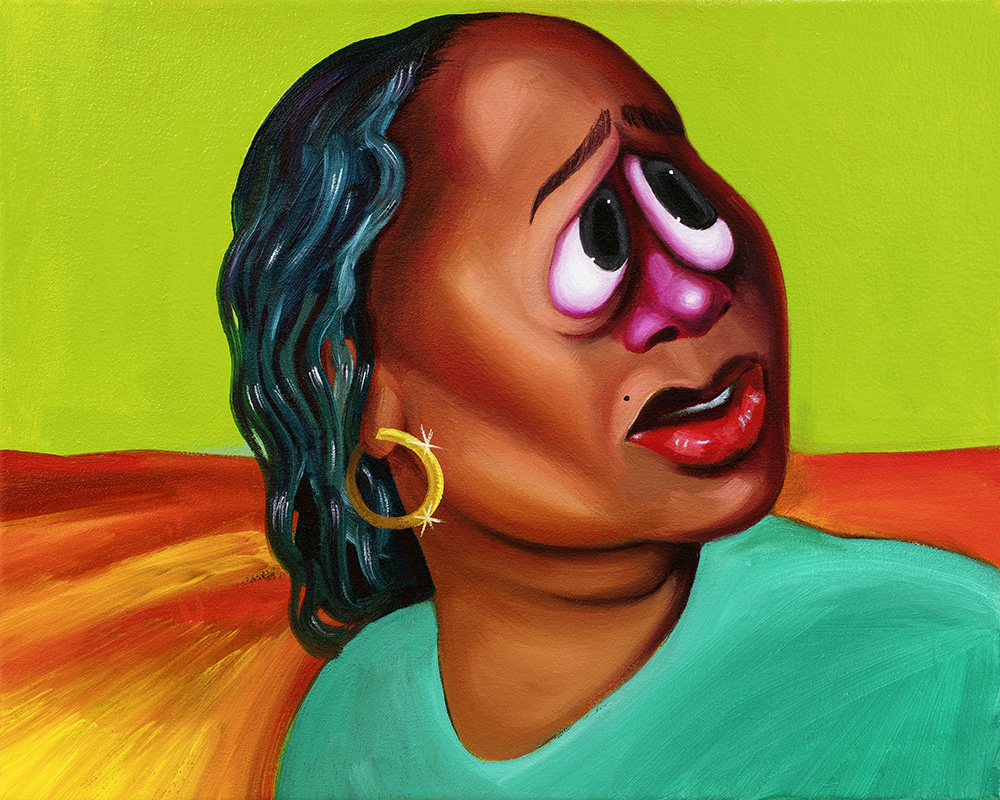
Clearly, you have a masterful touch with light. What significance do windows and doorways play in your work?
These symbols began to appear in my work for a couple of reasons. When I was a child, my dad would always take me to the library to check out some books. I never liked reading, so I always got art books that were full of pictures. That’s when I was first introduced to Vermeer. Other than his use of light, I remember loving that he depicted people in their homes, carrying out everyday tasks. This was significant for me, growing up, because I began making tons of drawings of people in domestic spaces. In college, I started to think about the way that light functioned in my neighborhood. I thought about the NYPD floodlights that are stationed in public housing courtyards and parks. I became interested in creating spaces where light coming through a window feels like an eerie presence. I like that I am able to blur the line between what is natural and what is reproduced as a form of surveillance. I also make a lot of interior scenes where you can’t tell whether it is a window or a painting of a landscape hung on the wall.
Doorways appear in the work a few times, but they feel a lot less significant, maybe because people are meant to walk through them. Windows feel more intimate and vulnerable to me.
A few works have clear ties to art history - i.e. The Fifth of May by Goya (1808) and Dead Christ by Andrea Mantegna (1480). What was it about these paintings that inspired you?
They’re both classics, and that’s so funny. I didn’t intentionally reference the Goya painting, but I love when that happens. I guess that one was subconscious. The Mantegna came about while thinking of ways to paint my father. At the time, he was having a lot of back problems and was bedridden. I liked the way the Dead Christ brought the viewer right to the foot of the bed so that you can see his scars. Replacing Jesus with my father felt symbolic in some way, too. The mourners beside him are replaced with my mother’s hands carrying melting ice. This piece definitely stands out from most of my work in a way that excites me. Supper at Emmaus by Caravaggio (1601) is referenced in another painting of mine, but nobody seems to notice.

Community is important to you. Can you talk a bit about the program you’re working with in the Bronx, and do you have any advice for young artists?
When I was in the sixth grade, my art teacher nominated a few students to join The Fred Dolan Art Academy. The Academy was a brand new art program for the children of the Bronx. They provided free supplies, metro cards, and lunch for any kid willing to give up their Saturday to come to class. Children’s book author and illustrator Neil Waldman founded the program, with the hope that we would be able to pursue a career in art in the future. I attended the program every Saturday until I graduated from high school. Now that I am back in the Bronx, I’ve been offered a teaching position in the program, working alongside the same faculty that taught me. The students just really want to be there. It feels good. I thought long and hard about what advice I’d give to young artists. Being a young artist myself, I feel like I am still learning how to navigate this landscape. I’ll just say the same thing that I was taught, and what I now tell all of my students—practice drawing from life as much as possible. That’s a weird piece of advice coming from me, I know. I don’t think I would be able to make my work if I hadn’t cultivated my skills in life drawing first. You can do just about anything once your foundations are solid. Drawing people on the train is my favorite thing to do.
What’s a typical day for you? Do you have any studio rituals you’d be willing to share?
I like to wake up at 7am and get to the studio by 9am every day. I always bring Goji (my dog) with me. She’s the best to have around because it gets pretty lonely working 12-hour days. I don’t have a ritual because I mostly go with however I'm feeling on that day. Sometimes, I’ll work on a piece nonstop for a couple of hours, and then reward myself with a break; other times I sit there for an hour mixing colors, it really just depends. The one thing that is always consistent is that I like listening to podcasts or audiobooks as I work, no music. I am currently listening to The Broken Earth Trilogy by N. K. Jemisin. I highly recommend it.
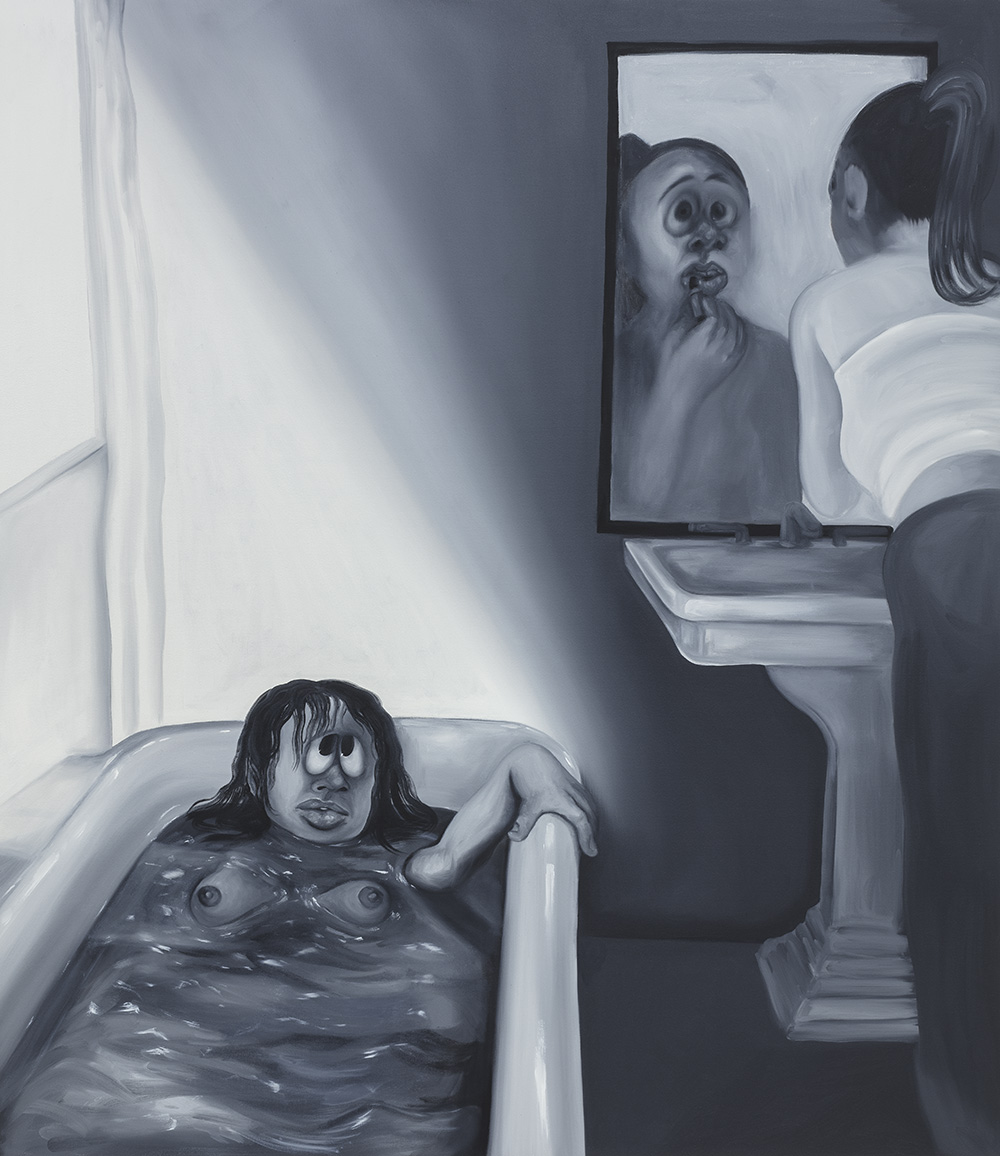
Definitely striking a chord, your figures possess serious pathos while aesthetically playing up what one critic coined as comic formalism. What is so fascinating about the human body, and how did you arrive at your signature style?
I’ve been making figurative work for as long as I can remember. I think it’s because I love people. My favorite parts to paint are eyes and hands; I think they hold a lot of emotion. While I was in college, people constantly asked me why I paint the figure, a process that was actually discouraged for my first couple of years in school. I ignored the criticism and continued making the work. I guess things changed because now everybody makes figurative paintings. Seeing that switch is kind of funny to me. I think this “style” developed over a long time—like since childhood. I picked up my first Manga in the first grade and was instantly obsessed. A lot of the story took place within the image, which was perfect for someone who loved narratives but hated reading. Visual storytelling is obviously something that stuck with me. I think cartoons are great because they’re outside of our reality, but not really. They’re hyperreal in a way. Also, there’s more to come. I hope to continue to transform, and develop my signature style.
You’ve garnered a fair amount of success for someone so young. What are you learning and do you have any career goals you’d like to share?
I’ve been fortunate so far; let’s hope I don’t fuck this up. I couldn’t even list all the things that I have learned so far. It’s been a lot, and I am still learning every day. I don’t have any goals I’d like to share at the moment.
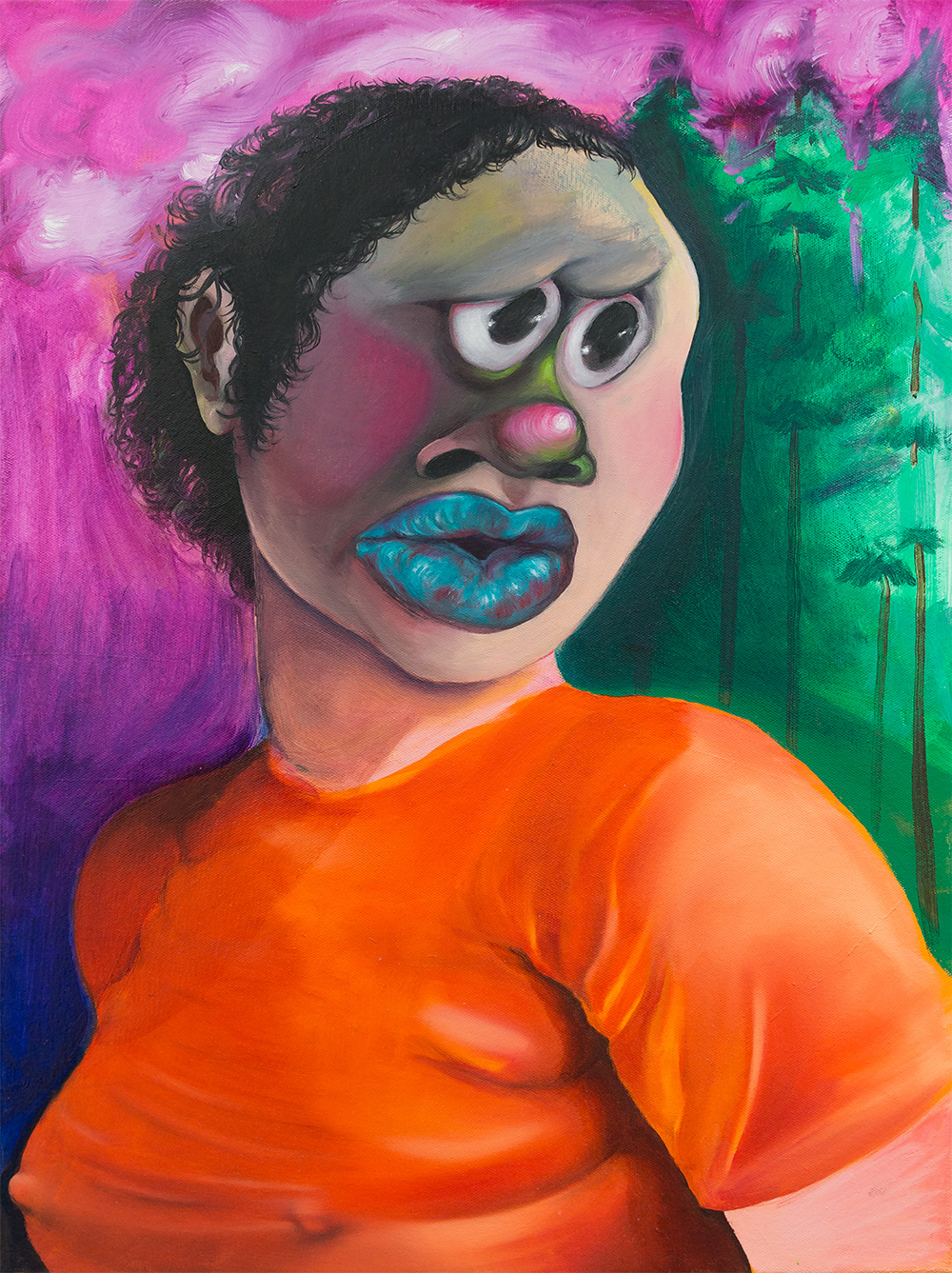
How much does intuition come into play in your work? Do you find it easy to trust yourself or do you have to consider a lot before making a move on canvas?
Intuition does play a huge role in my process. I'm all over the place most of the time. I’ll have multiple things going at once. One painting might develop from a small drawing I made, but, more often, things are completely improvised. I think working this way is liberating, but is also kind of difficult at times. I am constantly painting, wiping off, and then repainting until something recognizable emerges. I like to get tons of small canvases, maybe 10 or 20, and just go through all of them in one sitting. Larger works don’t typically come from these, and I don’t really show them to anyone. I feel like I just need this step in order to work towards the next piece. I think I've always worked this way, so it doesn’t feel hard to trust myself. If anything, I think I need to learn how to slow down sometimes.
cheyennejulien.com
@cheyennejulien

